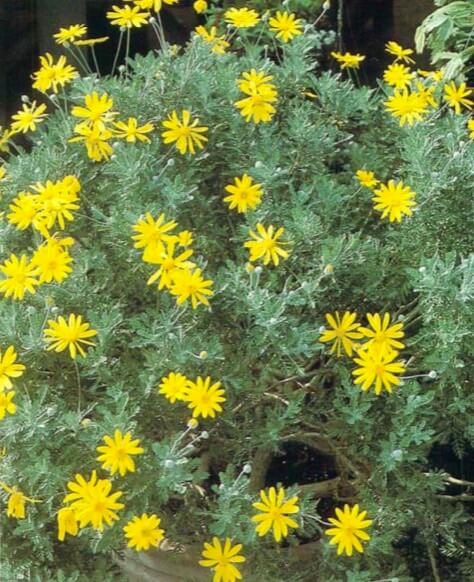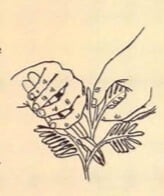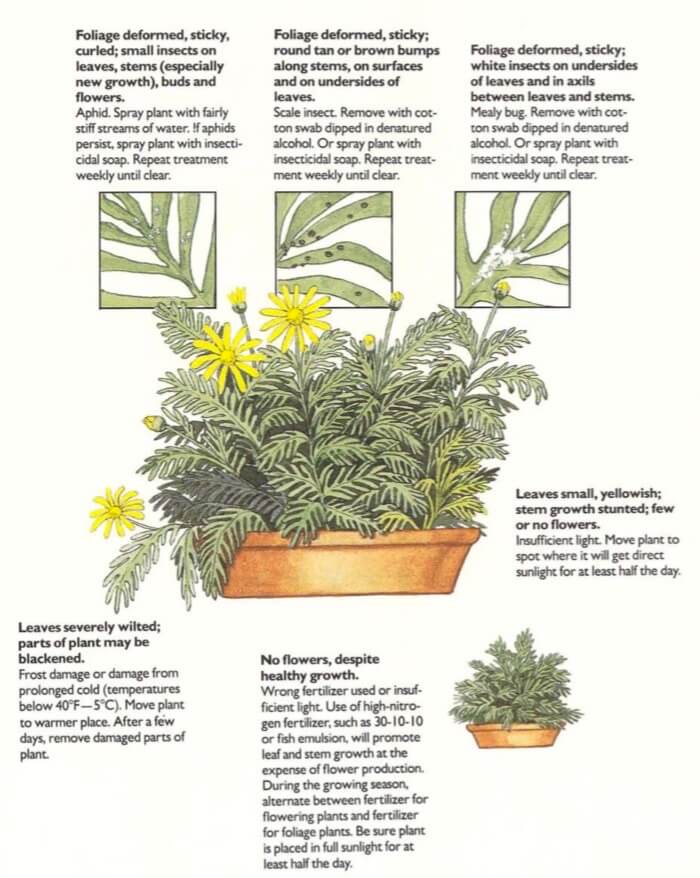[Ebook Việt Hoá] The Instant Guide to Healthy Houseplants (Hướng dẫn tức thời để chăm cây trong nhà khoẻ mạnh), Chi Euryops
[Ebook Việt Hoá] The Instant Guide to Healthy Houseplants: Euryops pectinatus (Gray-leaved euryops)
- Nguồn: [Ebook Việt Hoá] The Instant Guide to Healthy Houseplants (Hướng dẫn tức thời để chăm cây trong nhà khoẻ mạnh)
- Biên tập: Dũng Cá Xinh
- Biên dịch: Team Codai.net
English
The silvery leaves of this plant, native to South Africa, have deep cuts so fine that each leaf looks like a comb, the meaning of the Latin species name pectinatus. Bright yellow daisylike flowers, up to 2 inches (5 cm) across, appear nonstop in warm sunny weather, even on cuttings just a few inches tall. The plant can reach a height of 3 feet (90 cm) in a single growing season. In frost-free areas of the Sunbelt, the plant is evergreen and hardly ever without flowers. Elsewhere, it can be overwintered indoors, then cut back and repotted in spring, or new plants can be started from cuttings.

Light
Needs full sunlight for a half day or more each day.
Temperature
Grows and flowers best when temperatures range from 60-80°F (16-26°C). Plant tolerates temperatures as low as 41°F (SoC). At temperatures above 80°F (26°C), provide good air circulation and avoid leaving soil dry for prolonged periods.
Water
Plant is tolerant of drought but grows and flowers best when soil is moist below the surface and nearly dry at the surface. A plant in an outdoor container exposed to full sun and wind may need a daily soaking in hottest weather to prevent severe wilting.
Soil
Use almost any all-purpose potting soil or mix together equal parts garden loam, peat moss, sharp sand and well-rot-ted leaf mold or compost.
Feeding
Feed every 2 weeks in spring and summer, alternating between fertilizer for flowering plants and fertilizer for foliage plants. Do not feed in fall and winter, except in the Sunbelt, where monthly applications of fertilizer for flowering plants (15-30-1 5, for example) will encourage blooming.
Repotting
In spring, remove one-half to two-thirds of old soil and roots. Replant in fresh soil in the same size or size larger container.
Pruning
Cut back old plants by one-half to two-thirds in late winter or early spring, at the start of the new growing season. Cut off parts may be rooted as tip cut- tings. Through early summer, pinch out growing tips when they are 2 in (5 cm) long. This will encourage branching.
Propagation
Take tip cut tings of half-mature growth (neither the oldest growth, which becomes woody, nor the youngest, which is too soft). Set stems 1 in (2.5 cm) deep in moist rooting medium, such as equal parts peat moss and sharp sand.

What Goes Wrong

- Foliage deformed, sticky, curled; small insects on leaves, stems (especially new growth), buds and flowers: Aphid. Spray plant with fairly stiff streams of water. If aphids persist. spray plant with insecticidal soap. Repeat treatment weekly until clear.
- Foliage deformed, sticky; round tan or brown bumps along stems, on surfaces and on undersides of leaves: Scale insect. Remove with cot- ton swab dipped in denatured alcohol. Or spray plant with insecticidal soap. Repeat treatment weekly until clear.
- Foliage deformed, sticky; white insects on undersides of leaves and in axils between leaves and stems: Mealy bug. Remove with cotton swab dipped in denatured alcohol. Or spray plant with insecticidal soap. Repeat treatment weekly until clear.
- Leaves severely wilted; parts of plant may be blackened: Frost damage or damage from prolonged cold (temperatures below 40°F- 4°C). Move plant to warmer place. After a few days, remove damaged parts ofplant.
- No flowers, despite healthy growth: Wrong fertilizer used or insufficient light. Use of high-nitrogen fertilizer. such as 30-10-10 or fish emulsion, will promote leaf and stem growth at the expense of flower production. During the growing season, alternate between fertilizer for flowering plants and fertilizer for foliage plants. Be sure plantis placed in full sunlight for at least half the day.
- Leaves small, yellowish; stem growth stunted; few or no flowers: Insufficient light. Move plant to spot where it will get direct sunlight for at least half the day.
Tiếng Việt
Những chiếc lá bạc của loài cây này, có nguồn gốc từ Nam Phi, có những vết cắt sâu đến mức mỗi chiếc lá trông giống như một chiếc lược, ý nghĩa của tên loài trong tiếng Latinh là Cúc Trường Thọ. Những bông hoa cúc màu vàng tươi, có chiều ngang lên đến 2 inch (5 cm), phát triển không ngừng trong thời tiết nắng ấm, ngay cả trên cành giâm chỉ cao vài inch. Cây có thể đạt chiều cao 3 feet (90 cm) trong một mùa sinh trưởng. Ở những vùng không có sương giá ở vành đai mặt trời, cây thường xanh và hầu như luôn luôn ra hoa. Ở những nơi khác, nó có thể được ủ trong nhà, sau đó cắt tỉa và thay chậu vào mùa xuân, hoặc cây mới có thể được bắt đầu từ việc giâm cành.

Ánh sáng
Cần ánh sáng mặt trời đầy đủ từ 6 tiếng trở lên mỗi ngày.
Nhiệt độ
Sinh trưởng và ra hoa tốt nhất khi nhiệt độ từ 60-80 ° F (16-26 ° C). Cây chịu được nhiệt độ thấp tới 41 ° F (5 ° C ). Ở nhiệt độ trên 80 ° F (26 ° C), giúp không khí lưu thông tốt và tránh để đất khô trong thời gian dài.
Nước
Cây chịu hạn nhưng sinh trưởng và ra hoa tốt nhất khi đất ẩm dưới bề mặt và gần khô bề mặt. Cây trồng trong chậu ngoài trời tiếp xúc với đầy đủ nắng và gió có thể cần ngâm nước hàng ngày trong thời tiết nóng nhất để tránh bị héo.
Đất
Sử dụng hầu hết mọi loại đất bầu đa năng hoặc trộn các phần bằng nhau với đất mùn vườn, rêu than bùn, cát sắc và nấm mốc hoặc phân trộn đã mục nát.
Bón phân
Cứ 2 tuần một lần vào mùa xuân và mùa hè, sử dụng xen kẽ giữa phân bón cho cây ra hoa và bón cho cây ra lá. Không bón phân vào mùa thu và mùa đông, ngoại trừ ở vùng vanh đai mặt trời, nơi bón phân hàng tháng cho cây ra hoa (ví dụ: 15-30-15) sẽ khuyến khích hoa nở.
Thay chậu
Vào mùa xuân, loại bỏ một nửa đến hai phần ba đất và rễ cũ. Trồng lại trên đất mới trong cùng một kích thước hoặc khay chứa có kích thước lớn hơn.
Cắt tỉa
Cắt bớt cây cũ từ một nửa đến hai phần ba vào cuối mùa đông hoặc đầu mùa xuân, khi bắt đầu mùa sinh trưởng mới. Các phần bị cắt bỏ có thể được lấy rễ làm cành giâm ngọn. Vào đầu mùa hè, hãy nhúm các ngọn mọc khi chúng dài 2 inch (5 cm). Điều này sẽ khuyến khích sự phân nhánh.
Nhân giống
Lấy ngọn cành của cây vừa sinh trưởng (không phải cành già nhất, trở thành thân gỗ, cũng không phải cành non quá mềm). Đặt thân cây sâu 1 inch (2,5 cm) trong môi trường tạo rễ ẩm, chẳng hạn như rêu than bùn và cát sắc bằng nhau.

Những vấn đề có thể xảy ra

- Tán lá biến dạng, dính, quăn; côn trùng nhỏ trên lá, thân (đặc biệt là mới mọc), chồi và hoa: Rệp. Phun cây bằng những dòng nước khá cứng. Nếu rệp vẫn tồn tại, phun xà phòng diệt côn trùng cho cây. Lặp lại điều trị hàng tuần cho đến khi khỏi hẳn.
- Tán lá biến dạng, dính; Các vết sưng tròn màu nâu hoặc nâu dọc theo thân cây, trên bề mặt và mặt dưới của lá: Côn trùng vảy. Loại bỏ bằng tăm bông nhúng vào cồn biến tính. Hoặc phun xà phòng diệt côn trùng cho cây. Lặp lại điều trị hàng tuần cho đến khi khỏi hẳn.
- Tán lá biến dạng, dính; côn trùng trắng ở mặt dưới lá và ở nách giữa lá và thân: Bọ xít. Loại bỏ bằng tăm bông nhúng vào cồn biến tính. Hoặc phun xà phòng diệt côn trùng cho cây. Lặp lại điều trị hàng tuần cho đến khi khỏi hẳn.
- Lá bị héo nặng; các bộ phận của cây bị thâm đen: Hư hại do sương giá hoặc do lạnh kéo dài (nhiệt độ dưới 40 ° F- 4 ° C). Di chuyển cây đến nơi ấm hơn. Sau một vài ngày, loại bỏ các phần bị hư hỏng.
- Không có hoa, mặc dù sinh trưởng khỏe mạnh: Sử dụng sai phân bón hoặc không đủ ánh sáng. Sử dụng phân bón có hàm lượng nitơ cao, chẳng hạn như 30-10-10 hoặc đạm cá, sẽ thúc đẩy sự phát triển của lá và thân và ra hoa. Trong thời kỳ sinh trưởng, bón xen kẽ giữa phân bón cho cây ra hoa và phân bón cho cây ra lá. Đảm bảo chậu cây được đặt dưới ánh sáng mặt trời đầy đủ trong ít nhất nửa ngày.
- Lá nhỏ, hơi vàng; thân cây còi cọc; ít hoặc không có hoa: Không đủ ánh sáng. Di chuyển cây đến nơi có ánh nắng trực tiếp trong ít nhất nửa ngày.
![[Ebook Việt Hoá] The Instant Guide to Healthy Houseplants: Euryops pectinatus (Gray-leaved euryops) [Ebook Việt Hoá] The Instant Guide to Healthy Houseplants: Euryops pectinatus (Gray-leaved euryops)](https://vn1.vdrive.vn/codai.net/2020/02/ebook-huong-dan-tuc-thoi-cham-cay-trong-nha-khoe-manh-130-euryops-pectinatus.jpg)


